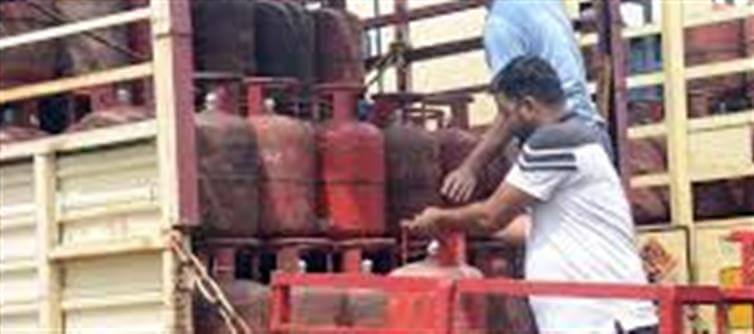
In a move that coincides with the auspicious occasion of Mahanavami during Sharadiya Navratri, state-owned oil marketing companies—IOC, HPCL, and BPCL—have increased the price of 19-kg LPG cylinders. This price hike is likely to affect households and businesses that rely on LPG cylinders for cooking and other activities. Here's a breakdown of the price changes and how it impacts various cities.
1. Price Increase for 19-kg LPG Cylinders
The price of a 19-kg LPG cylinder has seen an increase across the country. The exact hike may vary slightly from state to state due to factors like local taxes and transportation costs, but the increase is expected to be uniform across the major cities.
What Changed?
· The cost of a 19-kg LPG cylinder has gone up by ₹50-₹100, depending on the region.
· This hike comes at a time when many families are already dealing with the high inflationary pressure during the festive season.
2. LPG Price in Major Cities
Here’s a quick look at the new LPG cylinder prices across some of India’s major cities as of October 1, 2025:
a. Delhi
· New Price: ₹1,520
· Previous Price: ₹1,470
· Increase: ₹50
b. Mumbai
· New Price: ₹1,550
· Previous Price: ₹1,500
· Increase: ₹50
c. Kolkata
· New Price: ₹1,560
· Previous Price: ₹1,510
· Increase: ₹50
d. Chennai
· New Price: ₹1,590
· Previous Price: ₹1,540
· Increase: ₹50
e. Bengaluru
· New Price: ₹1,580
· Previous Price: ₹1,530
· Increase: ₹50
3. Impact of Price Hike on Consumers
This price hike will be felt by many who use LPG for cooking and heating. The increase in 19-kg cylinders is particularly important for those using commercial LPG (like small restaurants and food stalls), as it will directly raise their operational costs.
a. Household Impact
· Households relying on LPG cylinders for cooking will see an increased burden on their monthly expenditure.
· While this hike is relatively modest compared to the annual LPG price fluctuations, it comes at a time when people are already spending more due to the festive season.
b. Businesses
· Small restaurants, caterers, and food vendors that depend on 19-kg cylinders may face higher costs, potentially leading to price adjustments for consumers.
4. Why Did the Price Increase?
The price of LPG cylinders is closely linked to the global oil market and crude oil prices. Factors contributing to this price hike include:
· Global Crude oil Price Fluctuations: Changes in the price of crude oil and petroleum products directly affect the cost of refined products like LPG.
· Exchange Rate: A weaker rupee against the dollar can increase the cost of imported fuel, thus impacting domestic LPG prices.
· Seasonal Factors: There are often price hikes during peak consumption seasons, such as festivals and winter, when demand for heating and cooking fuel rises.
5. What Are the Alternatives?
For consumers looking to save on fuel costs, here are a few alternatives to consider:
· Induction Cooktops: If you have access to cheap electricity, induction cooktops can be a good option to reduce reliance on LPG.
· Solar Cooking: If you're looking for a long-term solution, solar cookers can help cut down on LPG consumption, especially in sunny regions.
· CNG or PNG: In cities with access to Compressed Natural Gas (CNG) or Piped Natural Gas (PNG), switching to these fuels can provide cost-effective alternatives.
6. How to Manage LPG Cost Increases
While price hikes are inevitable, here are some ways to manage your LPG expenses:
· Optimize Cylinder Usage: Reduce gas wastage by using pressure cookers, maintaining the burner in good condition, and cooking on a medium flame.
· Buy in Bulk: If possible, consider buying larger quantities of LPG at once to minimize transportation charges over time.
· Use Alternative Cooking Methods: Invest in electric stoves, microwaves, or air fryers that can help reduce LPG consumption.
7. Conclusion
The price increase in 19-kg LPG cylinders comes as an unwelcome surprise for many during the festive season. However, the hike is in line with the fluctuations in global crude oil prices, and such changes have become part of the norm over the years. Consumers are encouraged to plan their LPG usage more efficiently and consider alternative energy sources where feasible.
Disclaimer:
The views and opinions expressed in this article are those of the author and do not necessarily reflect the official policy or position of any agency, organization, employer, or company. All information provided is for general informational purposes only. While every effort has been made to ensure accuracy, we make no representations or warranties of any kind, express or implied, about the completeness, reliability, or suitability of the information contained herein. Readers are advised to verify facts and seek professional advice where necessary. Any reliance placed on such information is strictly at the reader’s own risk..jpg)




 click and follow Indiaherald WhatsApp channel
click and follow Indiaherald WhatsApp channel